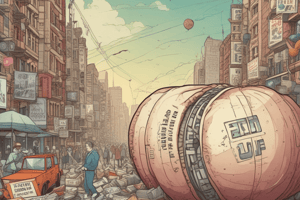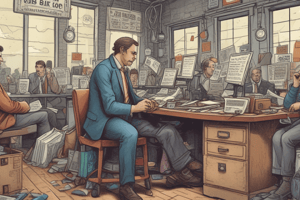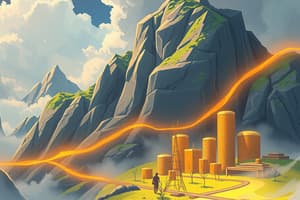Podcast
Questions and Answers
What is inflation defined as?
What is inflation defined as?
- A rapid increase in the production of goods and services
- A sustained increase in the general price level of goods and services (correct)
- A decrease in the overall economic output
- A sustained decrease in the general price level of goods and services
What is the main cause of demand-pull inflation?
What is the main cause of demand-pull inflation?
- Excessive money supply growth
- Increase in production costs
- Excess demand for goods and services (correct)
- External events affecting supply chains
What is the effect of inflation on fixed-income earners?
What is the effect of inflation on fixed-income earners?
- They benefit from inflation
- They are not affected by inflation
- They are protected from inflation by the government
- They lose purchasing power due to inflation (correct)
What is the main characteristic of hyperinflation?
What is the main characteristic of hyperinflation?
What is a monetary policy tool used to control inflation?
What is a monetary policy tool used to control inflation?
What is a supply-side policy aimed at controlling inflation?
What is a supply-side policy aimed at controlling inflation?
Flashcards are hidden until you start studying
Study Notes
Definition and Measurement
- Inflation: a sustained increase in the general price level of goods and services in an economy over time
- Measured as an annual percentage increase in the Consumer Price Index (CPI)
Causes of Inflation
- Demand-pull inflation: excess demand for goods and services, driving up prices
- Cost-push inflation: increase in production costs, such as higher wages or raw materials
- Monetary policy: excessive money supply growth, leading to too much money chasing too few goods
- Supply shocks: external events, such as natural disasters or global events, affecting supply chains
Effects of Inflation
- Redistribution of wealth: from fixed-income earners to borrowers, and from savers to debtors
- Uncertainty and volatility: making it difficult for businesses and individuals to make long-term plans
- Hyperinflation: extremely high inflation rates, rendering a currency nearly worthless
- Inequality: disproportionately affecting certain groups, such as fixed-income earners and those living on the poverty line
Types of Inflation
- Creeping inflation: a low, steady rate of inflation
- Galloping inflation: a rapid, high rate of inflation
- Hyperinflation: an extremely high, out-of-control rate of inflation
- Stagflation: a combination of high inflation and stagnant economic growth
Control of Inflation
- Monetary policy: central banks can increase interest rates to reduce money supply and curb inflation
- Fiscal policy: governments can reduce their spending and lower demand for goods and services
- Price controls: direct government intervention to limit price increases, often ineffective
- Supply-side policies: improving productivity and efficiency to increase output and reduce prices
Definition and Measurement
- Inflation is a sustained increase in the general price level of goods and services in an economy over time
- Measured as an annual percentage increase in the Consumer Price Index (CPI)
Causes of Inflation
- Demand-pull inflation: excess demand for goods and services, driving up prices
- Cost-push inflation: increase in production costs, such as higher wages or raw materials
- Monetary policy: excessive money supply growth, leading to too much money chasing too few goods
- Supply shocks: external events, such as natural disasters or global events, affecting supply chains
Effects of Inflation
- Redistribution of wealth: from fixed-income earners to borrowers, and from savers to debtors
- Uncertainty and volatility: making it difficult for businesses and individuals to make long-term plans
- Hyperinflation: extremely high inflation rates, rendering a currency nearly worthless
- Inequality: disproportionately affecting certain groups, such as fixed-income earners and those living on the poverty line
Types of Inflation
- Creeping inflation: a low, steady rate of inflation
- Galloping inflation: a rapid, high rate of inflation
- Hyperinflation: an extremely high, out-of-control rate of inflation
- Stagflation: a combination of high inflation and stagnant economic growth
Control of Inflation
- Monetary policy: central banks can increase interest rates to reduce money supply and curb inflation
- Fiscal policy: governments can reduce their spending and lower demand for goods and services
- Price controls: direct government intervention to limit price increases, often ineffective
- Supply-side policies: improving productivity and efficiency to increase output and reduce prices
Studying That Suits You
Use AI to generate personalized quizzes and flashcards to suit your learning preferences.




